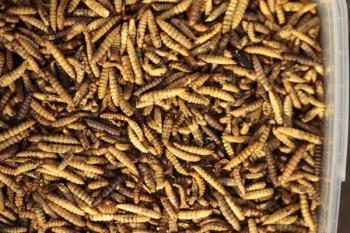
Evaluating diets and nutritional plans: How do I answer those questions? (Proceedings)
Pet food sales in the United States exceed 17 billion dollars. Veterinarians and veterinary staff are – and should be – a valuable source for nutritional recommendations.
According to the 2009-10 Pet Owners Survey, there are over 77 million owned dogs and 94 million owned cats in the United States. Over 62% of households in the United States own a dog or cat – often more than 1. Pet food sales in the United States exceed 17 billion dollars. Veterinarians and veterinary staff are – and should be – a valuable source for nutritional recommendations. Unfortunately, many pet owners rely on the internet, their neighbors, the grocery store, or pet store for this advice and much of this advice is unsubstantiated. Nutrition is important for maintenance of health, prevention of disease, and management of illness; therefore, understanding evaluation of pet foods and formulation of a nutritional plan in sickness and in health is important.
The two-step, iterative process
The American College of Veterinary Nutrition, a specialty college of board-certified nutritionists that are also veterinarians, recommends a two-step process in making nutritional recommendations. The process is iterative in that it should be re-evaluated periodically and changes made as deemed necessary.
The first step is ASSESSMENT. During this step, assess the ANIMAL, the DIET, and the FEEDING factors. ANIMAL FACTORS to be assessed include gathering historical information, performing physical examination, body condition scoring, and evaluating laboratory and imaging results if indicated. Gather information on any health or disease-related conditions, medications (including over-the-counter and nutraceuticals/supplements), reason for visit, and other household members. A thorough physical examination is performed and a body condition score assigned. There are 5- and 9- point body condition scoring systems; either can be used. Assigning a body condition score provides more information than body weight alone and takes into account muscle mass and tone.
DIETARY FACTORS include gathering information on dietary intake and inspection of the food, if needed. Take the dietary history from the person that actually feeds the pet(s) asking for type of food, amount fed, frequency of feeding, table food or treats, access to other food (garbage, outside, etc), supplements, and medications (including over-the-counter). If necessary, inspect a sample of the food or send a sample for analysis (i.e. Cornell Animal Health Diagnostic Center, Woodson Tenent Laboratories, EMSL Food and Consumer Products Testing Lab, etc). Pet foods can be purchased in a variety of forms – dry, canned, semi-moist, semi-dry, liquid, and frozen. In general:
*All types of products may be complete and balanced depending on the formulation. To determine if this is the case, be certain the label states that the product is complete and balanced for the life stage of the pet to which it is being fed.
Reading the food label is also beneficial. The food label can be roughly divided into a principal display panel and an information panel. The PRINCIPAL DISPLAY PANEL contains information directed towards the consumer including the product name, species for which the food is intended, net weight of product, and descriptive words and/or pictures (e.g. "new and improved", picture of a famous cat, etc). The INFORMATION PANEL contains the important information including ingredient list, guaranteed analysis, feeding guidelines, contact information, and the nutritional adequacy statement. Although often maligned and not as complete as labels for human foods, there is useful information to be found. Ingredients are listed in descending order according to pre-processing weight and names are set by AAFCO (e.g. by-product, etc); this means that ingredients containing moisture that weigh more will be listed first. Unfortunately, this does not give information as to the quality or exact amount of each ingredient; also, different forms of the same type of ingredient are listed separately. Chemical sounding ingredients are typically vitamins, minerals, and preservatives. Feeding guidelines are provided that are suitable for most, but not all, dogs or cats that consume the diet. The manufacturer's or distributer's name and address is required and questions regarding the food should be directed to them; they should be able and willing to provide answers. When contacting them, several questions should be asked:
1. Do you have a Veterinary Nutritionist or some equivalent on staff in your company? Are they available for consultation or questions?
2. Who formulates your diets and what are their credentials?
3. Which of your diet(s) is AAFCO Feed Trial tested? Which of your diets have been AAFCO Nutritional analyzed?
4. What specific quality control measures do you use to assure the consistency and quality of your product line?
5. Where are your diets produced and manufactured? Can this plant be visited?
6. Can you provide a complete product nutrient analysis of your best selling canine and feline pet food including digestibility values?
7. Can you give me the caloric value per can or cup of your diets?
The guaranteed analysis provides information regarding the 4 major components of a pet food as percentages of the diet as fed including minimum amount of crude protein, minimum amount of crude fat, maximum amount of crude fiber, and maximum amount of moisture. "Crude" refers to the analytical procedure and does not refer to the quality of the ingredient. Because the guaranteed analysis is in percentage as fed, it is difficult to compare products that differ in composition (e.g. dry product versus canned product); therefore, comparing products on a "dry matter" basis or on a gram per 100kcal basis is preferred. A down-and-dirty rule-of-thumb for comparison is:
• For dry foods – add 10% to nutrient of interest AF
o Ex. 21% protein AF = 21 + (21 × 0.1) = 21 + 2.1 = 23% protein DM
• For canned foods – multiply nutrient by 4
o Ex. 5% protein AF = 5 × 4 = 20% protein DM
The nutritional adequacy statement must be included and is designed to ensure that the product, when fed as the sole source of nutrition, is complete and balanced for one or more life stages, including how this adequacy was verified. The four recognized life stages by AAFCO are pregnancy, lactation, growth, and adult maintenance, and nutritional adequacy can be determined by feeding trials or by calculation. The calculation method involves determining the amount of nutrients in the diet and comparing to AAFCO nutrient profiles for that/those life stage(s). Feeding trials are performed by feeding the diet to the animals in that/those life stage(s) following AAFCO protocol. Feeding trials, while not perfect, provide indirectly information on bioavailability of nutrients and is preferred method for validation of nutritional adequacy. Therapeutic diets, supplements, and treats often do not carry a nutritional adequacy statement. Therapeutic diets are formulated for specific non-healthy conditions, which are not recognized by AAFCO and for which no nutrient profiles exist (e.g. renal failure, liver failure, etc); they usually carry a statement such as "intended for intermittent use" or "use only under the supervision or direction of a veterinarian". Snacks and treats are not formulated or intended to be the sole source of nutrition; therefore, they are not required to carry a nutritional adequacy statement.
The label often contains other information, much of which do not have official definitions. According to AAFCO, "natural" is "...only acceptable in reference to the product as a whole when all of the ingredients and components of ingredients meet the definition....the use of 'natural' is false and misleading if any chemically synthesized ingredients are present in the product; however, AAFCO recommends that exceptions be made in the cases when chemically synthesized vitamins, minerals, or other trace nutrients are present as ingredients in the product, provided that the product is not a dietary supplement and that a disclaimer is used to inform the consumer that the vitamins, minerals, or other trace minerals are not natural. For example, 'Natural with added vitamins, minerals, and other trace minerals.'" AAFCO defines "natural" as "a feed or ingredient derived solely from plant, animal, or mixed sources, either in its unprocessed state or having been subject to physical processing, heat processing, rendering, purification, extraction, hydrolysis, enzymolysis, or fermentation, but not having been produced by or subject to a chemically synthetic process and not containing any additives or processing aids that are chemically synthetic except in amounts as might occur unavoidably in good manufacturing processes." "Organic" does not have a specific AAFCO definition other than in reference to processing, "organic (process): a formula or a specific ingredient within a formula feed that has been produced and handled in compliance with the requirements of the USDA national Organic Program (7 CFR Part 205)." The USDA National Organic Program (NOP) "develops, implements, and administers national production, handling, and labeling standards for organic agricultural products. The NOP also accredits the certifying agents (foreign and domestic) who inspect organic production and handling operations to certify that they meet USDA standards." "Human grade" ingredient has no official definition and can be interpreted differently by different people; there are no standards by which to define or interpret this wording. Other designators such as "premium" and "gourmet" also have no official definitions. Such designators are arbitrary and subject to interpretation.
FEEDING FACTORS to be assessed include how the nutrition is provided and must take into account owner and animal factors. Simply filling a bowl within reach of the animal is not enough; the appropriate diet must be provided in the appropriate amount. Obesity is the most common nutritional disorder of dogs and cats and, in part, is due to overfeeding. "One cup" of food refers to the amount of food contained in one 8-ounce measuring cup. Ask specifically for the size of the cup used and the size of the bowl that is filled up. Many owners feed free choice – "drive-by feeders" - without regard to amount. The amount of energy required by the pet can be determined using one of two formulae:
Linear: [(30 × BWkg) + 70]
Exponential: 70 × (BWkg0.75)
This provides the RESTING ENERGY REQUIREMENT and this result is multiplied by a life stage or activity factor depending on the individual.
The second step is FORMULATION AND INITIATION OF A FEEDING PLAN. The nutritional plan is formulated based on the assessment phase and initiated. It is important that this plan is re-evaluated periodically (iterative process) and adjustments made based on what is found during assessment. Recommendations for the feeding plan are made based on life stage and physiological or pathological condition of the pet as well as the life style of the owner. Working within the constraints placed by the owner helps to ensure compliance; otherwise, recommendations will not be followed. There is no "one best" diet available for healthy pets or for pets that suffer from a disease. Oftentimes, many options exist including homemade diets.
Today's health care providers, veterinarians and technicians, need to be able to assess a pet, evaluate diets, and make recommendations on diets and feeding. Knowledge of assessment and formulation of a nutritional plan should be part of a patient's health care. Use body condition scoring in addition to weight to assess nutritional status. All pets need to eat – don't you want to influence this rather than ignoring it?
Resources
The ACVN (
Angell Memorial : 617 / 522 – 7282
Michigan State: 517 / 432 - 7782
Ohio State: 614 / 292 – 1221,
Tufts University: 08 / 839 – 5395 ext 84 696
UC Davis: 530 / 752 – 1387,
University of Missouri :
University of Tennessee: 865 / 974 – 8387
Newsletter
From exam room tips to practice management insights, get trusted veterinary news delivered straight to your inbox—subscribe to dvm360.






